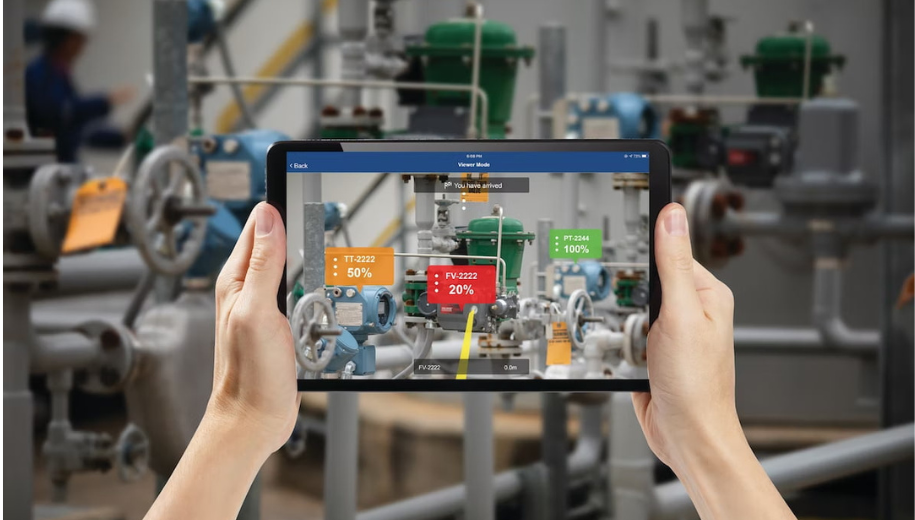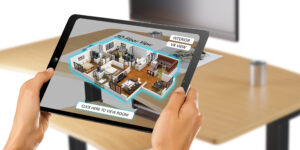
Modern business can no longer be imagined without innovative tools that help companies attract customer attention, increase engagement, and optimize internal processes. One of the most impactful technologies today is Augmented Reality (AR).
Currently, augmented reality in business is no longer a futuristic idea — it is a real working tool actively applied in marketing, education, retail, real estate, healthcare, and even in manufacturing. The fields of application of augmented reality are expanding every year, and the possibilities of this technology open up entirely new horizons for companies.
What is AR and Why is it Important for Business?
Augmented reality for business is a technology where digital objects, elements, and interactive content are overlaid on real-world images. With the help of smartphones, tablets, or AR glasses, users can see virtual 3D models, text, images, or animations seamlessly integrated into their physical surroundings.
This creates an effect of engagement, evokes strong emotions in customers, and provides a new format of interaction with brands.
Areas of Application of Augmented Reality
AR is being gradually integrated into various industries. Key areas include:
1. Marketing and Advertising
- Interactive AR campaigns generate a strong emotional response.
- AR advertising enables customers to visualize products before buying them.
2. Retail and E-commerce
- Virtual try-ons of clothing and accessories.
- Visualization of furniture in interiors using AR apps.
3. Real Estate
- Demonstration of 3D models of buildings and apartments.
- Virtual tours of properties before construction is complete.
4. Education and Corporate Training
- AR used for employee training in manufacturing.
- Visualization of complex processes and models for better understanding.
5. Industry
- Visualization of equipment and production processes.
- Step-by-step AR guides for repair and maintenance.
6. Healthcare
- Demonstration of anatomical 3D models.
- Training of specialists with AR simulations.
Advantages of AR for Business
| Advantage | Description |
| Engagement | Interactive content increases customer interest. |
| Emotional Effect | AR creates strong positive emotions and associations with the brand. |
| Faster Decision-Making | Ability to “try” products in real space reduces hesitation. |
| Resource Savings | Reduced need for physical demonstrations and prototypes. |
| Brand Reinforcement | AR positions a company as innovative. |
| Interactive Training | AR improves learning efficiency for employees and clients. |
Comparison: Traditional Methods vs. AR
| Criterion | Traditional Methods | AR Technologies |
| Engagement | Limited | High, thanks to interactivity |
| Visualization | Photos/videos | Realistic 3D models and objects |
| Training Efficiency | Medium | Much higher due to kinesthetic perception |
| Emotions | Weak | Strong, “wow-effect” |
| Demonstration Costs | High | Lower due to digital content |
How AR Transforms Customer Interaction
AR shifts communication to an entirely new level. While traditional advertising was static, now users can interact with digital objects in real space.
Examples:
- Virtual try-ons of shoes and clothing.
- Visualization of a new TV in your living room.
- Testing how a new wall color changes the interior.
Examples of AR Implementation in Business
- IKEA Place: app for visualizing furniture in interiors.
- L’Oréal: virtual try-on of cosmetics.
- Pepsi Max: AR campaign on bus shelters with interactive effects.
- BMW: AR apps to showcase new car models.
Challenges of AR Adoption
Despite its advantages, AR adoption faces certain difficulties:
- High cost of developing high-quality AR apps.
- Limited availability of AR devices and the need for mass adoption.
- High demands for creativity and unique content.
Prospects for AR Development in Business
According to analysts, by 2030 augmented reality for business will become a standard in many industries.
Main trends:
- Integration with AI for personalized content.
- AR in B2B: virtual showrooms and business presentations.
- AR-commerce: virtual marketplaces.
- Integration with the Metaverse: new interaction formats.
Augmented reality in business is not just a passing trend but a real technology already reshaping the market. It helps companies increase engagement, optimize processes, strengthen brand image, and create new emotions for consumers.
The fields of application of augmented reality are so diverse that every company can find a suitable tool — from marketing to industrial use.
In the future, AR will become an integral part of business processes, and companies that begin implementing it today will gain a strategic advantage tomorrow.




